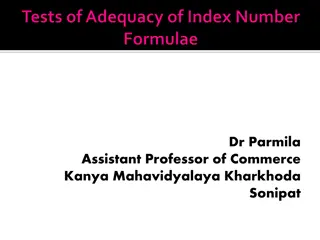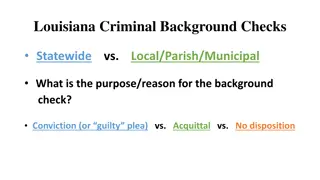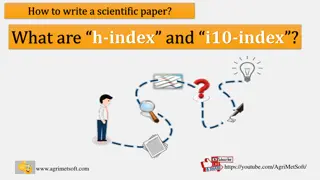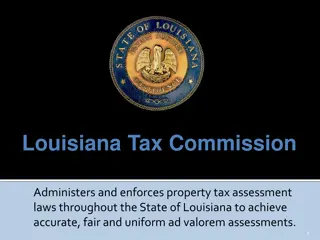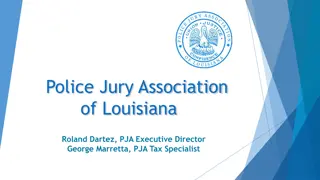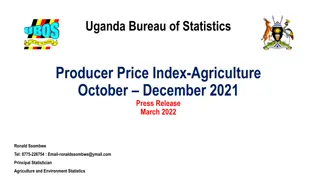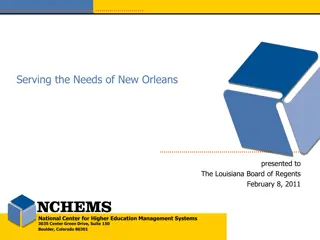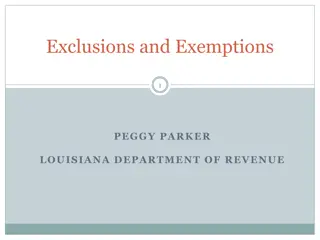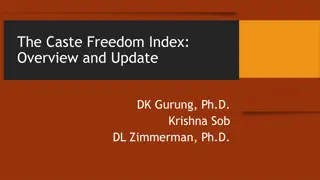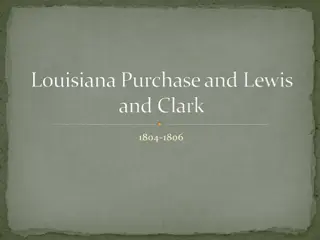Understanding Louisiana's Interests and Opportunities Index
Louisiana's ESSA plan includes an Interests and Opportunities indicator to ensure schools offer a well-rounded education to students. This involves exposure to various learning areas and skill development. The state emphasizes the need for a fair, valid, and reliable measure that aligns with its values and expectations for all students. The current policy involves schools selecting indicators for evaluation to determine an overall Interests and Opportunities Index score.
Download Presentation

Please find below an Image/Link to download the presentation.
The content on the website is provided AS IS for your information and personal use only. It may not be sold, licensed, or shared on other websites without obtaining consent from the author. Download presentation by click this link. If you encounter any issues during the download, it is possible that the publisher has removed the file from their server.
E N D
Presentation Transcript
Agenda I. Overview of Interests & Opportunities Index II. Reviewing the Menu III. Annual Process IV. 2023-2024 Timeline 3
Purpose of Interests and Opportunities Louisiana s ESSA plan proposed an Interest and Opportunities indicator to measure whether schools are providing students with access to a well- rounded education, exposing them to diverse areas of learning in which they can develop their skills and talents, including visual and performing arts, foreign language, technology, co-curricular activities, advanced coursework, health/PE, career pathways, etc. In the 2023-2024 school year, this will continued to be measured through a menu-based approach where schools will select indicators across four domains. 5
Background on Interests & Opportunities Over the last several years, the LDOE has worked with local stakeholders and national experts to develop this new measure. Louisiana stakeholders have articulated the need for a measure that: is simple and easy to implement while also valid and reliable like all of Louisiana s accountability measures; is fair for all schools and school systems regardless of size and access to resources; provides a menu of means by which schools can demonstrate success; and represents Louisiana s values and high expectations for all students. 6
Previous Policy Prior to 2022-2023, the Interests and Opportunities policy in Bulletin 111 required: 1. All schools, K-12, submit a survey to share how they were implementing Interests and Opportunities measures in their school. Schools earned credit for submitting their survey annually. a. K-8 schools received 75 points out of 150 for submitting their survey b. 9-12 schools received 150 points out of 150 for submitting their survey 2. K-8 schools had a measure of their course enrollment in Physical Education, Visual Arts, Performing Arts, and World Languages. Schools received up to 75 points. 7
Current Policy In 2022-2023 the Department began evaluating schools based on the indicators that they select as a part of the menu-based approach. Annually, all schools K-12, must select four indicators that will be evaluated to determine an overall Interests and Opportunities Index score. This includes all K-12 sites (even K-2 stand alone sites), alternative schools, and nonpublic schools participating in the scholarship program. These results are then used to produce School Performance Scores (or the Scholarship Cohort Index for nonpublic schools). 8
Calculating the Interests and Opportunities Index Annually all schools must: 1. Select four indicators annually that meet any specified criteria 2. Submit their selections through the annual Jotform 3. Receive superintendent (or their designee) validation for selections via the annual Jotform 4. Submit their annual data as a part of the existing collection process and verify that the data submitted is correct 5. Submit any necessary documentation as a part of the data collection process in Louisiana Data Review (LDR), if applicable 9
The Menu-based Approach Continuing in the 2023-2024 school year, the LDOE will use a menu-based approach for the Interests & Opportunities Index. The LDOE annually publishes a list of indicators associated with each domain. Domains serve as broad groupings of offerings related to students interests (in BESE policy). Indicators are the specific measures that can capture the extent to which a school is advancing students interests and opportunities. 11
Domains The Domains include: The Arts Extracurricular Activities STEM (Science, Technology, Engineering, and Math) World Languages Schools will be required to select indicators from at least two different domains. Schools are not allowed to select ALL of their indicators from only one domain. Schools are not required to select all four domains. 12
Indicators Indicators are the ways in which a school will demonstrate that they are providing opportunities that align to the selected domain. Within each domain, there are a variety of indicators that a school may select as the basis for their index score. For example an indicator in the STEM domain is School has students enrolled in coursework specific to a High School STEM pathway. 13
Data- vs Documentation-based Indicators Data-based Indicators Documentation-based Indicators A minimum of three (3) indicators must be data-based indicators. Data- based indicators are calculated by using the data collected by the Department as a part of current data collections. Up to one indicator per school can be based on data not currently collected by the LDOE. School systems will submit any documentation needed to substantiate an indicator via the Interests and Opportunities Data Review System. 14
The Menu The Menu includes the following information: All indicators available and which Domain they are in The reference code for each indicator (for example: TA1 for The Arts 1) Applicable Grade Bands Data Sources Scoring Structure Documentation or Data Needed Category (data or documentation) 15
Understanding the Menu What is required for scoring Explains which data source is used for calculation (if applicable) The reference code identifies each indicator Which grades are included in individual indicators Whether the indicator is data-based or documentation-based How the indicator is scored 16
The Menu The Menu is published annually in the spring on the Accountability Library. See below for the links to the 2022-2023 and 2023-2024 Menus. 2022-2023 Interests and Opportunities Menu 2023-2024 Interests and Opportunities Menu 17
Annual Process for Interests and Opportunities Fall 2023 August 2023 Spring 2023 LDOE provides school systems with a validation report of the indicators their schools selected. LDOE releases a survey to all schools for them to select their domains and indicators for that accountability year. LDOE releases guidance on the list of indicators and the data to be used in scoring. Spring 2024 Spring-Summer 2024 LDOE reviews documentation and produces final results roster for school systems. Fall 2024 As a part of the data review process, school systems upload documentation substantiating indicator results based on data not collected by LDOE. LDOE releases I&O Index results to public as part of SPS and annual report cards. 19
Indicator Selection Process Step 1 The Department opens the Jotform for indicator selection by school. Each school leader (contact information is pulled from Sponsor Site) receives a letter with their unique submission code and the link to access the Jotform Each school system Accountability Contact receives a letter with directions and the unique submission code for all schools in their system If a school leader does not receive their information, the school system Accountability Contact should share it with them. Step 2 Schools select their indicators through the Jotform Step 3 School system superintendents (or their designees) validate selections Once validated, the school s selected indicators will not be allowed to be modified for that school year. 20
Calculating Points at the Indicator Level Number of Required Indicators Number of Indicators based on Data Collected by LDOE Number of Indicators based on School-Submitted Documentation Points Per Indicato r Possible Index Points (assuming all indicators were scored as no points or full points) 4 3 1 37.5 0, 37.5, 75, 112.5, 150 21
Calculating Points at the Indicator Level The Interests and Opportunities Index is based on a 150 point scale. The total points possible across all the number of selected indicators would have to add up to 150. As part of the menu-based approach, guidance would be provided for each indicator that outlines how the indicator will be scored and what data or documentation would be used in the scoring determination for that indicator. EXAMPLE: For the indicator School has students who earn college-credit for World Languages courses (AP, IB, DE, CLEP, etc.), the LDOE would leverage student course enrollment data already collected by the LDOE to determine the rate used in the scoring determination for that indicator. 22
Scoring Structures The two main scoring structures are detailed below. 1. No credit or full credit a. These indicators must meet the criteria in the Documentation/Data Needed column to earn full credit b. If the data or documentation does not meet the criteria, the school will earn a 0 for the indicator. 2. 0-100% of Points Possible a. Indicators are calculated based on the data collected. If 75% of students are enrolled in the course codes listed, then the school will earn 75% of points available for the indicator or 28.125 points. 23
Scoring Structures In addition to the standard scoring structures, there are two indicators that have partial credit that can be earned. S4- School has adopted a high-quality science curriculum Schools will earn 100% of points (37.5) if the entire school has HQIM adoption Schools will earn 50% of points (18.75) if there is only partial HQIM adoption in certain grades/cohorts/classes 24
Scoring Structures S8- School submits an application and receives a nationally-recognized award in STEM or submits an application Schools will earn 100% of points (37.5) if they earn an award or certification Schools will earn 50% of points (18.75) if they submit an application but do not earn an award or certification 25
Data-Based Indicator Scoring The Department will use data from each collection to calculate the data- based indicators. For this reason, it is critical that the data submitted is validated and correct as a part of the collection process annually. Indicators that are based on course enrollment (or completion) are calculated based on the total number of students enrolled in the applicable grade levels and the total number of students in those grade levels in the listed course codes. 26
Data-Based Indicator Scoring For example, TA 2 is calculated by using the following steps. 1. Determine the total enrollment for all arts courses listed on the second tab. 2. Determine the number of students enrolled total in the grades applicable in column D. For example, a K-3 school denominator would be their K-3 enrollment. A 4-6 school would have their 4-5 enrollment be their denominator. 1. Calculate the number of points earned by the number of enrolled in arts/the number of students total based on the grade band in column D. 27
Documentation-Based Indicator Scoring The purpose of documentation-based indicators is to give schools an opportunity to earn credit for experiences and learning that happens outside of data that is collected by the Department annually. Annually, schools that selected a documentation-based indicator must upload documentation into LDR. Schools will have until June each year to submit their documentation to the system. The Department will continue to create cover pages for the documentation with a checklist for school systems to ensure all documentation is included. 28
Producing Index Results The LDOE will: Maintain the secure collection of all data and documentation needed to calculate indicator results. Review documentation to ensure it meets the scoring criteria outlined in the published menu guidance. The LDOE will use this data and documentation to calculate indicator results for each school along with an overall Interests & Opportunities Index score. In August following the completion of the school year, the LDOE will provide a validation report of all indicator results for school systems to review and validate as part of an annual data certification process. 29
Submitting Documentation for 2022-2023 Louisiana Data Review (LDR) for 2022-2023 Interests and Opportunities is open. Schools that selected a documentation-based indicator must upload documentation into LDR by June 7, 2023 or the indicator will earn zero points. The new LDR guidance, Interests and Opportunities Louisiana Data Review Guidance, can be be found in the Accountability Library. Please contact accountability@la.gov with questions. 31
Interests and Opportunities 2023-2024 Timeline Menu and Course Codes Published March 2023 Final Guidance Published June 2023 Indicator Selection Survey Opens (Jotform) August 14, 2023 Indicator Selection Survey Closes (Jotform) November 3, 2023 Indicator Selection Validations Due (Jotform) November 8, 2023 Interests and Opportunities Data Review Opens March 25, 2024 Interests and Opportunities Data Review Closes June 7, 2024 32
Resources All resources are available in the Accountability Library on louisianabelieves.com. If you have any additional questions, please email accountability@la.gov. 33



